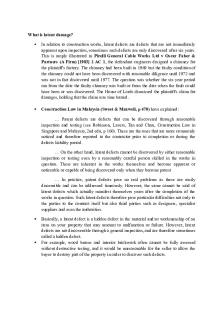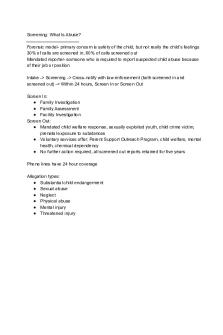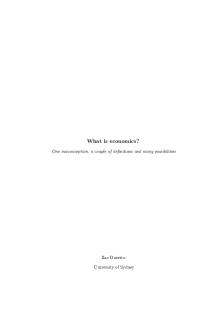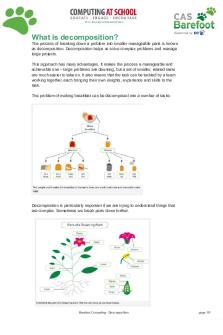What Is Meat Science - Lecture notes 1 PDF

| Title | What Is Meat Science - Lecture notes 1 |
|---|---|
| Author | Camryn Schatzlein |
| Course | Meat Science |
| Institution | California Polytechnic State University San Luis Obispo |
| Pages | 6 |
| File Size | 119.4 KB |
| File Type | |
| Total Downloads | 64 |
| Total Views | 146 |
Summary
Download What Is Meat Science - Lecture notes 1 PDF
Description
Meat Science What is meat science? The study of muscle characteristics as they transform into meat Basis properties of tissue (color, marbelization, toughness) Facets of the industry: Animal production Breeding, feeding, management Meat quality starts at the ranch Animal Welfare Transportation and slaughter Market system: from production to packing plant Market signals: primary line of communication between consumers and producers Determines what livestock and/or poultry to produce Organic, grass fed, ect. To label for consumers Technology Maintain product quality/ wholesomeness and develop new and different products Modify convenience, price, quality, uniformity, nutrition value, novelty Around 12,000 ya: gathering-> cultivation 10,000 ya: domestication of animals 2000 BS: meat processing (Egypt) 7th C. BC: Israelites developed slaughter laws and practices, “Deuteronomy” 17th Century: salt packing industry helped develop the practices to preserve meat, advances in meat packing 1865: Union Stock Yard 1862: Lincoln founded the US Department of Agriculture Responsible for the safety of meat, poultry, and egg products 1890: First form of inspection only for meats intended for export No program to detect diseased animals Only intended for export commerce 1906:
Publishing of The Jungle, Upton Sinclair Sinclair toured stockyards and slaughterhouses interviewing laborers and city workers Intended to highlight the poor persons lifestyle and work environment but later turned into an expose on the meat industries disgusting production of food First Meat Inspection Act and Food & Drug Act MIA required federal inspection at processing plant before and after slaughter, processing, and facilities FISI: Food Safety and Inspection Services Food and Drug Act Administered by FDA: Food and Drug Administration (Not USDA) Responsible for oversight of all other foods including shelled eggs, wild game meats, fish, seafood, plus drugs, cosmetics, and medical devices 1920-50 Stockyards: aimed to have everything close by (centralized location) All products were processes within the same plant from slaughter to processed products Were the main two hubs and were the most centralized Chicago and Kansas City 3-4 major companies that processed the entire line of production 1950-90 Growth of federal highway system and refrigerated trucks to allow meat packers to move out of expensive urban areas Competition led to more sophisticated and mechanized plants in less expensive rural areas Slaughter: IBP, Swift Processing: Oscar Meyer, Golden State Foods 1957: Poultry Products Inspection Act Ensure that poultry products shipped in interstate commerce are continuously inspected 1958: Humane Slaughter Act Eisenhower Requires all packers to provide anesthetization or instant stunning by mechanical or electrical means prior to killing of cattle, calves, horses, mules, sheep, swine, with the exception of kosher slaughter 80% of livestock, doesn’t apply to chickens 1978 Law expanded to imported meats that exported to the US must meet the US standards
USDA empowered to stop slaughtering line on the spot if cruelty is observed until further changes occur 1986: Processed Products Inspection Improvement Act Amends the Federal Meat Inspection Act to further describe the manner, frequency of meat inspections Nature and fréquence of processing Inedible food for human consumption sent away could still be used for pet food or livestock and other purposes 1990- Today 1998: Regulated pathogen reduction and Hazard Analysis Critical Control Point (HACCP) Rule focuses on the prevention and reduction of microbial pathogens on raw products that can cause illness HACCP clarifies the respective roles of government and industry Industry: produce safe food Government: set appropriate food safety standards, maintain vigorous inspection oversight to ensure those standards are met, and maintain strong enforcement to deal with noncompliance Shift in inspection philisophy Implementation of HACCP made the processor more accountable for outbreaks Reassigned risks to industry and plant Today: Large harvest companies become vertically integrated (large companies control each sector of processing but still separate them out) by purchasing/ creating processing divisions 2019: top 3 meat producers: JBS: 60 plants Tyson: 110 plants Cargill: 36 plants HACCP: 1959: HACCP was created Implemented in 1998 Pillsbury worked with the US Army auto create Food for Space for NASA Concern: crumbs, microbiology Conclusions: needed control of entire process including raw materials, processing environment, even food handlers 1971: National Conference on Food Protection Three Principals of Food
1. Identification and assecment of potential hazards throughout growing, harvest, and processing 2. Determine Critical Control Points (CCPs) in order to control identified hazards 3. 3. Create a monitoring system for all identified CCPs 4. Definition of Critical Control Point (CCP): A point in production where a loss of control would result in an unacceptable food safety risk 1988: National Advisory Committee on Microbiological Criteria for Foods (NACMCF) Scientific advisory committee to the Secretaries of Agriculture, Commerce, Defense, and Health & Human Services 1989: Created the description for the Seven Principles of HACCP 1. 2. 3. 4. 5. 6. 7.
Conduct a hazard analysis Determine the critical control points Establish critical limits Establish monitoring procedures Establish corrective actions Establish verification procedures Establish record-keeping and documentation procedures
1993: Hamburgers contaminated with E. coli O157:H7 infected over 700 people, killing 4 children and leaving over 100 with permanent kidney and brain damage Believed to be caused by meat being contaminated by fecal material on the kill floor Jumpstarted the implementation of HACCP principles in the ground beef industry McDonald Corporation’s ground beef patty producers worked with Colorado State University to develop and teach a HACCP plan to beef packers Top CCPs addressed: Skinning Eviscerating Final Washing Chilling and Fabricating Storing and Distribution United Stated Department of Agriculture Food Safety Inspection Services Government sector in control of meat product safety and handling All meat products regularly inspected by FSIS FSIS: branch within USDA Funded by taxes Packer only responsible to pay for overtime (> 8hrs/day or 40hrs/week)
Current FSIS budget: $1 billion 80% of budget is spent on personnel salaries and benefits About 9,600 personnel workforce is devoted to inspection and other frontline duties, such as investigations and laboratory testing About $3.25/person FSIS regulated 6,000+ meat, poultry, and egg product establishments across the country Inspector are often Vets of DVM's Industry Sectors: 1. 2. 3. 4.
Harvest- Slaughter Fabrication- cutting meat Processing- making ground beef, sausage, bacon, etc, Rendering- use of all other animal products so nothing goes to waste
Slaughter Start of the process Fabrication Conversion of carcass into wholesale portions and/or retail cuts Wholesale and primal (“chunks”) Food service, retailers, or wholesale Retail cuts What you buy in a restaurant Processing Adding value to fresh meat past fabrication (marinating, smoking, curing, cooking) Hot dogs, smoked sausage, kabobs, bacon Rendering Process of reducing, converting, or melting down animal tissue (primal fat) by heating Developed on 1800’s Disposal of waste from packing plants, even dead animals from farms and feed lots Prevents tons of highly perishable, potentially dangerous waste materials from entering the environment “Original recycling" Supports R&D: discovers more ways to efficiently utilize byproducts through new processes and products
Develop and adopt new technologies to best prevent air and water pollution in surrounding areas 36 billion lbs of animal waste 9 bill of that is just fat...
Similar Free PDFs

Lecture 1: What Is Multilingualism?
- 25 Pages

What is htttp - computer science
- 4 Pages

Meat Tag - Lecture notes 2
- 1 Pages
Popular Institutions
- Tinajero National High School - Annex
- Politeknik Caltex Riau
- Yokohama City University
- SGT University
- University of Al-Qadisiyah
- Divine Word College of Vigan
- Techniek College Rotterdam
- Universidade de Santiago
- Universiti Teknologi MARA Cawangan Johor Kampus Pasir Gudang
- Poltekkes Kemenkes Yogyakarta
- Baguio City National High School
- Colegio san marcos
- preparatoria uno
- Centro de Bachillerato Tecnológico Industrial y de Servicios No. 107
- Dalian Maritime University
- Quang Trung Secondary School
- Colegio Tecnológico en Informática
- Corporación Regional de Educación Superior
- Grupo CEDVA
- Dar Al Uloom University
- Centro de Estudios Preuniversitarios de la Universidad Nacional de Ingeniería
- 上智大学
- Aakash International School, Nuna Majara
- San Felipe Neri Catholic School
- Kang Chiao International School - New Taipei City
- Misamis Occidental National High School
- Institución Educativa Escuela Normal Juan Ladrilleros
- Kolehiyo ng Pantukan
- Batanes State College
- Instituto Continental
- Sekolah Menengah Kejuruan Kesehatan Kaltara (Tarakan)
- Colegio de La Inmaculada Concepcion - Cebu












